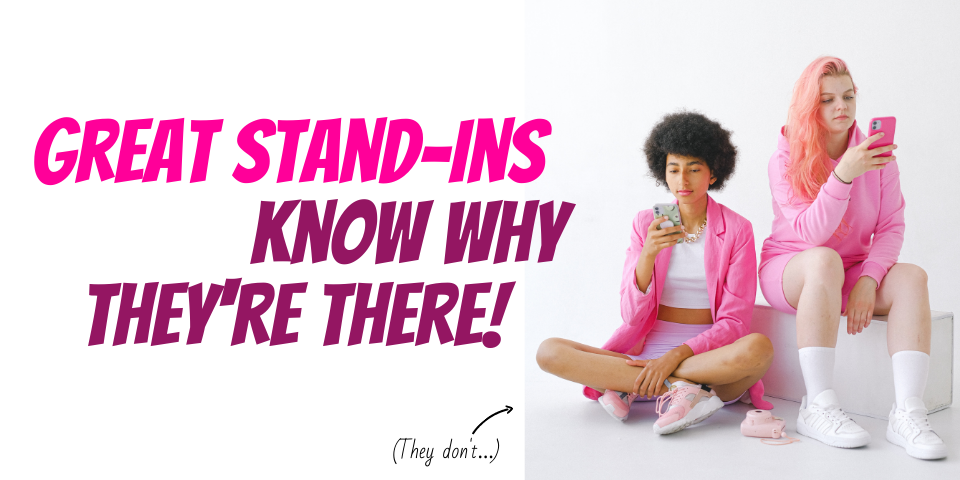Many people booked to work as a “stand-in” on a TV show or a film have no idea what a stand-in does. (No worries! That’s why there’s Stand-In Central and our ebook, The Stand-In Handbook!)
Of the people who think they “know” what a stand-in does, many are sadly limited in their knowledge.
For these people, being a stand-in is just standing where production tells you to stand, sitting where they tell you to sit, etc.
What that often means in this day and age is this type of stand-in loses focus quickly, gets bored, pulls out a phone, looks down at the phone, maybe talks on the phone, … all while “standing in.”
Admittedly, some of the best stand-ins can pull this off. But the difference between these zoned-out stand-ins and the best stand-ins is that the best stand-ins get why they’re there.
And if the best stand-ins pull out their phone while they’re on their mark, it’s likely because they have a pretty good sense it’s okay for them to do it at that moment. They’re not always right, but they’re also not completely zoned out.
Why Stand-Ins Are There
In general, a stand-in is on a TV or film set to help the crew set up a shot. That generally means to light the shot, set up the camera in the preferred area, and rehearse the basics of the shot.
Note that I didn’t say, “A stand-in is on a TV or film set to stand on a mark.”
Of course, standing on a mark comes with the territory. But standing on a mark serves the greater objectives of the production: lighting, setting up the camera, and rehearsing.
Standing on a mark is not all there is to standing in.
When You Know Why You’re There, Your Value Skyrockets as a Stand-In
Stand-ins who know why they’re there serve productions’ multiple interests better. As a result, it’s not uncommon for these stand-ins to become more valuable to a production, giving these stand-ins steadier work in an essentially unsteady line of work.
For example, stand-ins who know they are there to light a shot, know that means to pay attention to the DP, the gaffer, what lights are directed toward them, what lights not to stand in front of, and to stay decently still, faced in the direction(s) your actor did in the rehearsal.
In these ways, you are a great tool for the crew to light a shot just right. If you aren’t keen to these interests, you’re going to inevitably frustrate production. After all, even if you don’t know it, they are putting a lot of focus on you!
Stand-ins who know they are there to rehearse a shot, know that means to pay close attention to the marking rehearsal to what their actors do (and the timing of the different actors’ movements), understand where the cameras are and what actions they’re trying to capture, understand the amount of speed (or slowness) that’s appropriate for a rehearsal, and listen carefully to instructions from the camera operators, AD, or even the director.
Again, doing these things makes you a great tool for the crew! They will want to work with you, because you make their work easier. (And it is work!)
Conclusion
It’s funny when a first-team actor is politely asked to stand in for himself or herself for a bit.
A first-team actor standing in is usually not very aware of what professional stand-in work involves. Many times they’ll talk openly to other people while they’re being lit, get out their phone, and so on.
That’s not to fault first-team actors! That’s to say that they don’t necessarily even get what stand-in work really involves.
So, the next time you stand in on a TV set or a film shoot, ask yourself how you can better serve the production personnel who need you to stand in. Maybe that means focusing a bit more, listening a bit more, even anticipating how they might need you.
If you do this, you may find you’re asked back again. And again. And again!
Has knowing the purpose of a stand-in helped you shine on the job? Share your experiences in the comments below!







Leave A Comment